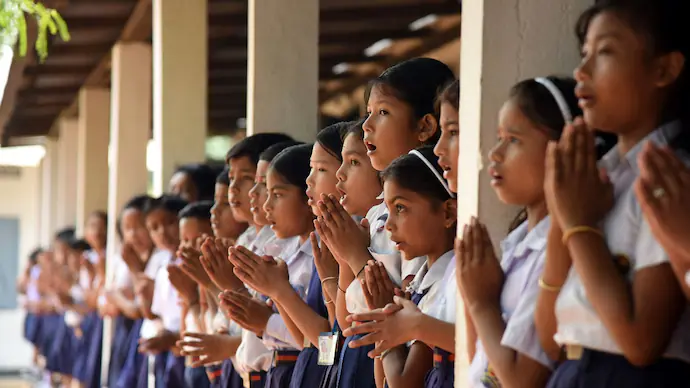Historic Shift in Indian Education: Mughal Myths Out, Gita Enters School Prayers
- Sonali Singh
- Aug 25
- 3 min read
A historic transformation is underway in Indian education, as distorted Mughal glorification is replaced by truthful history, and the sacred wisdom of the Bhagavad Gita begins to resonate in daily school prayers, reaffirming Sanatan Dharma’s enduring legacy.
For the followers of Sanatan Dharma, there are two pieces of news that fill the heart with immense joy and pride. The first is a courageous reformation in educational content by NCERT, and the second is a spiritual revival in schools of Uttarakhand, both marking a profound shift in how young minds are nurtured. These changes reflect not just policy adjustments but a return to our true cultural and shastric roots.

Reclaiming Our Historical Narrative: Mughals No More the “Great”
For many decades, Hindu children were taught a soft and polished version of history. Mughal rulers were shown as heroes, with Akbar often called “The Great.” This version of history hid many hard truths. It ignored the violent invasions by the Mughals. It did not speak of the lakhs of Hindus who were killed. It also skipped over the destruction of thousands of temples. This kind of history was not true to what our scriptures and oral traditions have told us. It was far from the eternal truth, or sanatangyan, passed down through generations.
From a Sanatan perspective, history is not just about kings and empires—it’s about the battle between dharma (righteousness) and adharma (unrighteousness). Changing or hiding the truth of our past damages our cultural identity and spiritual strength. Understanding this, NCERT has taken an important step to set the record straight. School textbooks will no longer ignore the harsh realities of history. The cruelty during the Mughal period will now be told honestly. At the same time, more attention will be given to real Indian heroes like Chhatrapati Shivaji Maharaj and Maharana Pratap. They stood for dharma and inspired the whole nation.
This change is not just about correcting history. It’s about reclaiming our true identity. The Bhagavad Gita, our ancient holy book, reminds us of this.
धर्मसंस्थापनार्थाय सम्भवामि युगे युगे। — Bhagavad Gita 4.7
(For the protection of the righteous, the destruction of evil-doers, and the establishment of Dharma, I manifest myself age after age.)

The Return of the Bhagavad Gita to School Prayers: A Sacred Revival
The second major change is happening in Uttarakhand. The state has courageously introduced the daily reading of a shloka from the Bhagavad Gita in all its schools during morning prayers. Along with the shloka, students also learn its meaning and explanation. This is important because it brings back the old gurukul style of teaching. In those times, education was always connected with spiritual lessons.
The Bhagavad Gita is the greatest Hindu scripture. It teaches timeless lessons about dharma (duty), karma (actions), and devotion. These lessons guide not only individuals but whole societies to live rightly. When children recite the Gita every day, it helps grow their minds and spirits. It also connects them to our eternal Sanatan way of life.
A well-known verse from the Bhagavad Gita (Chapter 2, Verse 47) fits perfectly here:
"कर्मण्येवाधिकारस्ते मा फलेषु कदाचन।
मा कर्मफलहेतुर्भूर्मा ते सङ्गोऽस्त्वकर्मणि॥"
“You have the right to perform your prescribed duties, but you are not entitled to the fruits of your actions. Never consider yourself the cause of the results of your activities, nor be attached to inaction.”
This sage teaching encourages children to focus on righteous action without attachment to external results—truly a fitting spiritual foundation for education.

Sanatan Dharma: The Eternal Path Lighting Up Modern Education
Sanatan Dharma means the eternal way. It teaches that knowledge and spirituality are connected. Long ago, Indian education was based on Vedic wisdom and holy books. This knowledge was shared by respected teachers and saints in gurukuls, traditional learning centers. Over time, the modern education system lost this connection. It became more focused on secular subjects and often shared distorted stories.
The inclusion of true history and the Gita’s wisdom is a step towards restoring sanatangyan in education—allowing our youth to imbibe dharma alongside academics. Maharshi Ved Vyasa wrote the Mahabharata, which has the Gita in it. He said education helps us learn about ourselves. It also guides us to live in a good and honest way.

This important change in Indian education is more than just a new curriculum. It is a revival of culture and spirituality. By fixing false history and bringing the Bhagavad Gita back into schools, India is reconnecting with its roots in Sanatan Dharma. These changes not only bring back the truth but also help create a new generation that values dharma, pride, and timeless wisdom. This connects our past with a meaningful future.

Comments